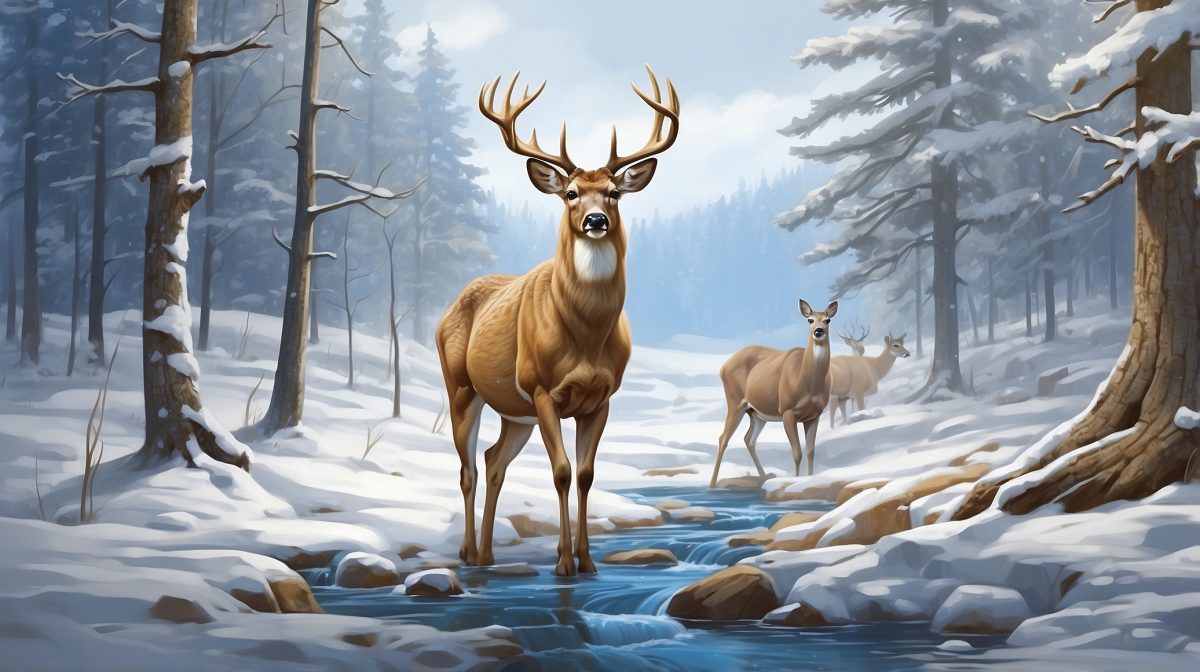Understanding Whitetail Behavior
First off, knowin’ your quarry like the back of your hand is key. Whitetail deer, they’re creatures of habit, see? They got their own patterns, movements, and habits that can tell you a whole lot if you’re payin’ attention. For instance, bucks tend to follow similar trails to food sources and waterin’ holes. And let’s not forget how the seasons and weather can shake things up. A shift in temperature or a change in the wind can make all the difference in deer activity.
Now, when it comes to understandin’ these behaviors, it’s all about observation. You gotta be willin’ to spend time watchin’ and learnin’. See how them deer move at different times of the day, and take note of what they’re munchin’ on. This kind of knowledge is priceless when you’re out there tryin’ to pinpoint where the big bucks are hidin’.
Scouting Gear Essentials
Alright, let’s talk gear. When you’re headin’ out to scout, you don’t wanna be caught unprepared. A good pair of binoculars, some detailed maps, and a few trail cameras can set you up right nice. But it ain’t just about havin’ the tools—it’s about knowin’ which ones are gonna serve you best. You gotta choose gear that’s reliable and suited for the terrain you’re coverin’.
And here’s a little insider tip: don’t overlook the importance of scent control and camo. If you wanna get close to these critters without spookin’ ’em, you gotta blend in and stay downwind. That means coverin’ your tracks with scent eliminators and dressin’ in camo that matches the local foliage. It’s all about bein’ invisible out there.
Scouting Techniques
Now, when it comes to puttin’ boots on the ground, there’s a few techniques that’ll serve you well. You gotta be willin’ to do a little trekkin’, lookin’ for signs like rubs, scrapes, tracks, and bedding areas. These signs are like readin’ a story—they’ll tell you where the deer have been and where they’re likely to head next.
And here’s a piece of advice: learn to move quietly and stay undetected. It’s all about patience and takin’ your time. Move slow, keep your eyes peeled, and listen for any sounds. You’d be surprised how much you can learn about deer movement just by sittin’ still and payin’ attention to the woods around you.
The Role of Technology in Scouting
Don’t get me wrong, the old ways are good, but there’s a place for technology in scouting too. Trail cameras, for instance, can be your eyes in the woods when you can’t be there. Set ’em up near trails or food sources, and you’ll get a good idea of what’s passin’ through and when. And let’s not forget about mobile apps and mapping software—these tools can help you keep track of your scouting efforts and plan your next move.
But here’s the trick: you gotta know how to analyze the data you collect. It’s not just about havin’ pictures of deer; it’s about understandin’ what those pictures tell you. Look for patterns in movement, times of day, and even the size of the deer you’re seein’. That’s how you’ll start to put together the pieces of the puzzle.
When to Scout
Scoutin’ ain’t just about where you look; it’s also about when you look. The time of day can make a big difference in deer activity. Early mornin’ and late evenin’ are prime times, but don’t discount those midday hours, especially during the rut. Deer can be active any time of day if the conditions are right.
And when it comes to the calendar, scoutin’ ain’t a one-and-done deal. You gotta be out there before the season starts and keep at it durin’ the season. Pre-season lets you find the deer and their patterns, while in-season scouting helps you adjust to any changes in deer behavior. Just remember, the more time you spend scoutin’, the better your chances come huntin’ season.
Habitat and Food Sources
Knowin’ the lay of the land is just as important as knowin’ the deer. Whitetails, they prefer certain habitats—places with good cover, food, and water. Learn to read the land, lookin’ for the kind of thickets and woods that deer love. And keep an eye out for food sources like acorns, browse, and food plots. These are gonna be hotspots for deer activity.
And don’t you forget about water sources and travel corridors. Deer need water just like any other critter, and they’ll often use the same paths to get to it. Find these travel routes, and you’ll find the deer. It’s all about piecin’ together the puzzle of where they eat, drink, and bed down.
The Scout’s Mindset
Now, if there’s one thing I can’t stress enough, it’s the importance of patience in scoutin’. You can’t expect to find that trophy buck on your first trip out. It takes time, dedication, and a whole lotta sittin’ and waitin’. But let me tell ya, it’s worth it when you finally lay eyes on that big ol’ buck.
And you gotta be persistent. Make regular trips out to your scoutin’ spots, keep detailed notes, and learn from what you see. It’s this kind of persistence that pays off in the long run. You’ll start to see patterns, understand the deer’s behavior, and eventually, you’ll be in the right place at the right time. That’s what scoutin’ is all about.
Conclusion
Scouting for whitetail deer in the Texas Hill Country, or anywhere for that matter, is more than just a weekend hobby—it’s a craft that takes dedication and a sharp mind. Remember, every hour spent learnin’ the land and understandin’ the deer is an investment towards that heart-pounding moment when you spot the perfect buck. With these tips and techniques, you’ll be well on your way to scoutin’ success. Good luck out there, and happy huntin’!
FAQs
How long before the hunting season should I start scouting?
You’ll want to start scoutin’ at least a month before the season opens, but the earlier the better. This gives you time to understand deer patterns and make your plans.
What’s the biggest mistake beginners make when scouting for whitetails?
The biggest mistake is movin’ too fast and makin’ too much noise. You gotta be stealthy and patient to avoid spookin’ the deer.
How often should I check my trail cameras?
Check ’em every couple of weeks to minimize disturbance, but adjust the frequency based on what you’re seein’ and the time of year.
Is there a particular time of day that’s best for scouting?
Dawn and dusk are prime times for deer movement, but don’t discount any time of day, especially durin’ the rut.
Can you scout too much and risk disturbing the deer?
Yes, you can. Be mindful of your presence in the woods. Scout smart, not hard, and always minimize your impact on the deer’s natural behavior.


